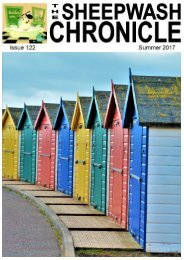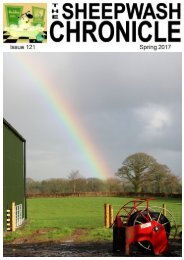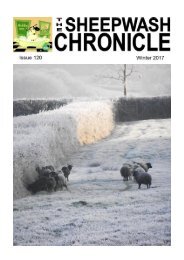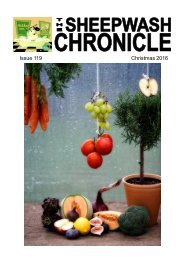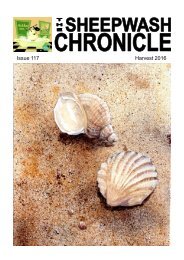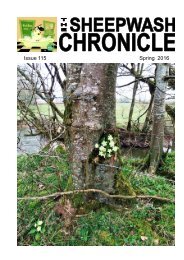Sheepwash Chronicle Autumn 2016 edition
The Sheepwash Chronicle is a magazine for and about the residents of the little village of Sheepwash in Devon.
The Sheepwash Chronicle is a magazine for and about the residents of the little village of Sheepwash in Devon.
Create successful ePaper yourself
Turn your PDF publications into a flip-book with our unique Google optimized e-Paper software.
<strong>Autumn</strong> Thoughts<br />
The weather has been a fickle jade this summer, with some<br />
absolutely scorching and humid periods and then some awful<br />
wet times - however, we must bear up and accept whatever<br />
comes!<br />
Our swallows and martins seem to have left, with never a fond<br />
farewell - one day they’re there, the next gone, only a few<br />
stragglers left. It is amazing, I think, that the youngsters leave<br />
after the parents but still know where to go.<br />
We now await the arrival of the winter visitors and all that can<br />
be heard in the garden at the moment is the winter song of the<br />
robin, the only bird that sings all year round to protect its<br />
territory.<br />
If you’re lucky you could be hearing the roar of stags (red deer)<br />
and bucks (fallow deer) at rut, though I haven’t seen a deer, except the odd Roe, for quite some time. Along<br />
the under road towards Totleigh Barton was a good place to hear the fallow deer, and south of the road to<br />
Hatherleigh for red deer. (There is a place called Rutleigh in that direction - could this be significant?)<br />
Whilst on wildlife, rabbits seem to be in profusion, and devastating some people’s gardens, but luckily not<br />
mine or my allotment. I’ll keep my fingers crossed!<br />
Unintentionally, that leads rather nicely on to gardening. Now is the time to harvest apples, and what a<br />
crop it seems to be! Pears will be ready a little later. Thin out and trim summer fruiting raspberries and tie<br />
them in to their framework.<br />
The flower garden needs attention now, with the lifting and splitting of perennials, using the outside parts<br />
of the clumps when replanting. Collect seeds from flowering plants when they’re dry, and store in paper<br />
bags for sowing next spring. Lift and dispose of tired and dying summer bedding, fork over the areas, and<br />
fertilise with a low nitrogen feed, as you don’t want excessive lush green growth going into winter, as this<br />
can encourage disease.<br />
Plant spring bedding. Also, plant daffodil bulbs now (tulips can be left until November). If need be, Acers<br />
can be pruned at this time of year – if they’re left until spring they will bleed when cut – but be careful not<br />
to tear the bark as this can let in disease.<br />
In the vegetable garden, dig over bare ground for winter, incorporating compost or manure to be ready for<br />
planting next spring. Garlic should be planted – each clove up to about two inches deep in October/early<br />
November – and winter onion sets can be planted now, but not as deep, just under the surface will suffice.<br />
Now is also the time to plant spring greens, six inches apart and one foot between rows, so that every other<br />
plant can be used as spring greens and the others left to heart up, but if you’ve got a slug and snail problem<br />
like I have it’s probably a waste of time, as you’ll only be feeding the blighters!<br />
Continue checking winter greens for caterpillars, slugs, and snails. We’re trying nematodes to control the<br />
slugs, and I’ve also set out some beer traps, which have succeeded in stupefying and drowning a lot of<br />
slugs. I wish I knew of a similar way to control snails.<br />
While on the subject of gastropods (that’s slugs and snails to you and me) I read a very disturbing article<br />
the other week concerning slug pellets. I know I bang on about using the safer ferric phosphate and not the<br />
metaldehyde ones (the blue ones), but this concerned dogs (I don’t know about cats). The blue<br />
metaldehyde pellets are mixed with the same cereal base most dog foods are made of, which makes them<br />
highly palatable. Half a cup (or 80 gms) is enough to kill a fully-grown Labrador, states Dr Ed Blane of<br />
Natural England. One poor man in Norfolk lost three dogs in one day.<br />
The pellets can spill out in piles as they are being spread on crops, so be aware and be careful when walking<br />
around fields or using them around the garden. Maybe it’s time to accept that a few holes in the Hostas are<br />
better than a dead dog.<br />
Jeremy Burden<br />
21



